Business Research: Employee Motivation and Woolworths Performance
VerifiedAdded on 2021/06/15
|18
|4107
|101
Report
AI Summary
This report examines the impact of employee motivation on organizational performance, focusing on a case study of Woolworths, Australia. The research explores the conceptual understanding of employee motivation, differentiating between intrinsic and extrinsic factors, and analyzes how motivation influences company performance. The study investigates various motivational strategies, including empowerment, self-improvement through training, and job rotation, to enhance employee engagement and productivity. The methodology includes qualitative research, utilizing interviews and questionnaires with human resource managers to gather primary data. The report addresses research questions regarding motivation, organizational performance, and employee motivation strategies. The findings are expected to provide insights for Woolworths and other organizations seeking to improve employee motivation and overall business outcomes. The study also highlights the need for companies to create a positive work environment that encourages innovation and employee satisfaction, thereby contributing to the success of the retail industry.

Running head: BUSINESS RESEARCH
Paraphrase This Document
Need a fresh take? Get an instant paraphrase of this document with our AI Paraphraser
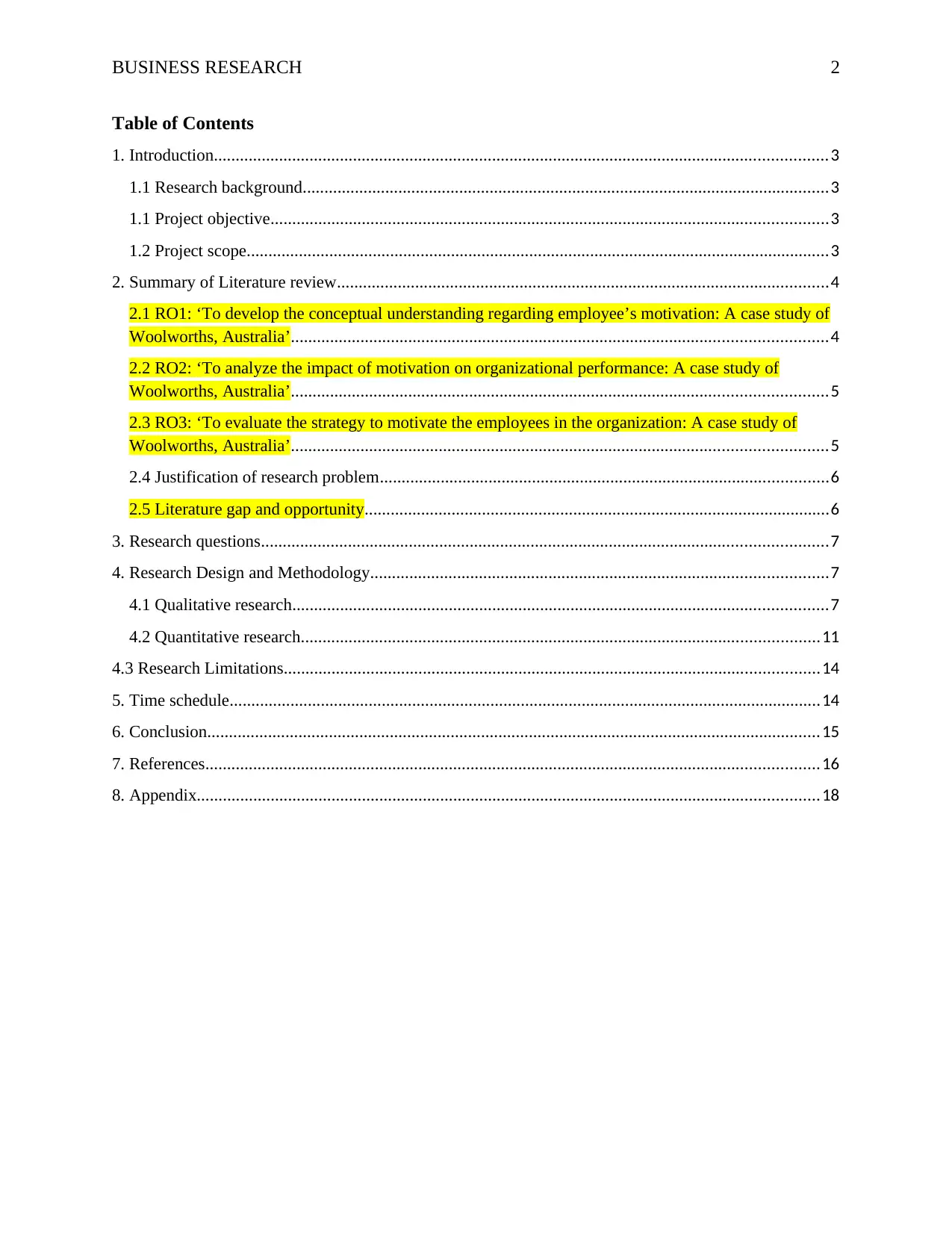
BUSINESS RESEARCH 2
Table of Contents
1. Introduction.............................................................................................................................................3
1.1 Research background.........................................................................................................................3
1.1 Project objective................................................................................................................................3
1.2 Project scope......................................................................................................................................3
2. Summary of Literature review.................................................................................................................4
2.1 RO1: ‘To develop the conceptual understanding regarding employee’s motivation: A case study of
Woolworths, Australia’...........................................................................................................................4
2.2 RO2: ‘To analyze the impact of motivation on organizational performance: A case study of
Woolworths, Australia’...........................................................................................................................5
2.3 RO3: ‘To evaluate the strategy to motivate the employees in the organization: A case study of
Woolworths, Australia’...........................................................................................................................5
2.4 Justification of research problem.......................................................................................................6
2.5 Literature gap and opportunity...........................................................................................................6
3. Research questions..................................................................................................................................7
4. Research Design and Methodology.........................................................................................................7
4.1 Qualitative research...........................................................................................................................7
4.2 Quantitative research.......................................................................................................................11
4.3 Research Limitations...........................................................................................................................14
5. Time schedule........................................................................................................................................14
6. Conclusion.............................................................................................................................................15
7. References.............................................................................................................................................16
8. Appendix...............................................................................................................................................18
Table of Contents
1. Introduction.............................................................................................................................................3
1.1 Research background.........................................................................................................................3
1.1 Project objective................................................................................................................................3
1.2 Project scope......................................................................................................................................3
2. Summary of Literature review.................................................................................................................4
2.1 RO1: ‘To develop the conceptual understanding regarding employee’s motivation: A case study of
Woolworths, Australia’...........................................................................................................................4
2.2 RO2: ‘To analyze the impact of motivation on organizational performance: A case study of
Woolworths, Australia’...........................................................................................................................5
2.3 RO3: ‘To evaluate the strategy to motivate the employees in the organization: A case study of
Woolworths, Australia’...........................................................................................................................5
2.4 Justification of research problem.......................................................................................................6
2.5 Literature gap and opportunity...........................................................................................................6
3. Research questions..................................................................................................................................7
4. Research Design and Methodology.........................................................................................................7
4.1 Qualitative research...........................................................................................................................7
4.2 Quantitative research.......................................................................................................................11
4.3 Research Limitations...........................................................................................................................14
5. Time schedule........................................................................................................................................14
6. Conclusion.............................................................................................................................................15
7. References.............................................................................................................................................16
8. Appendix...............................................................................................................................................18
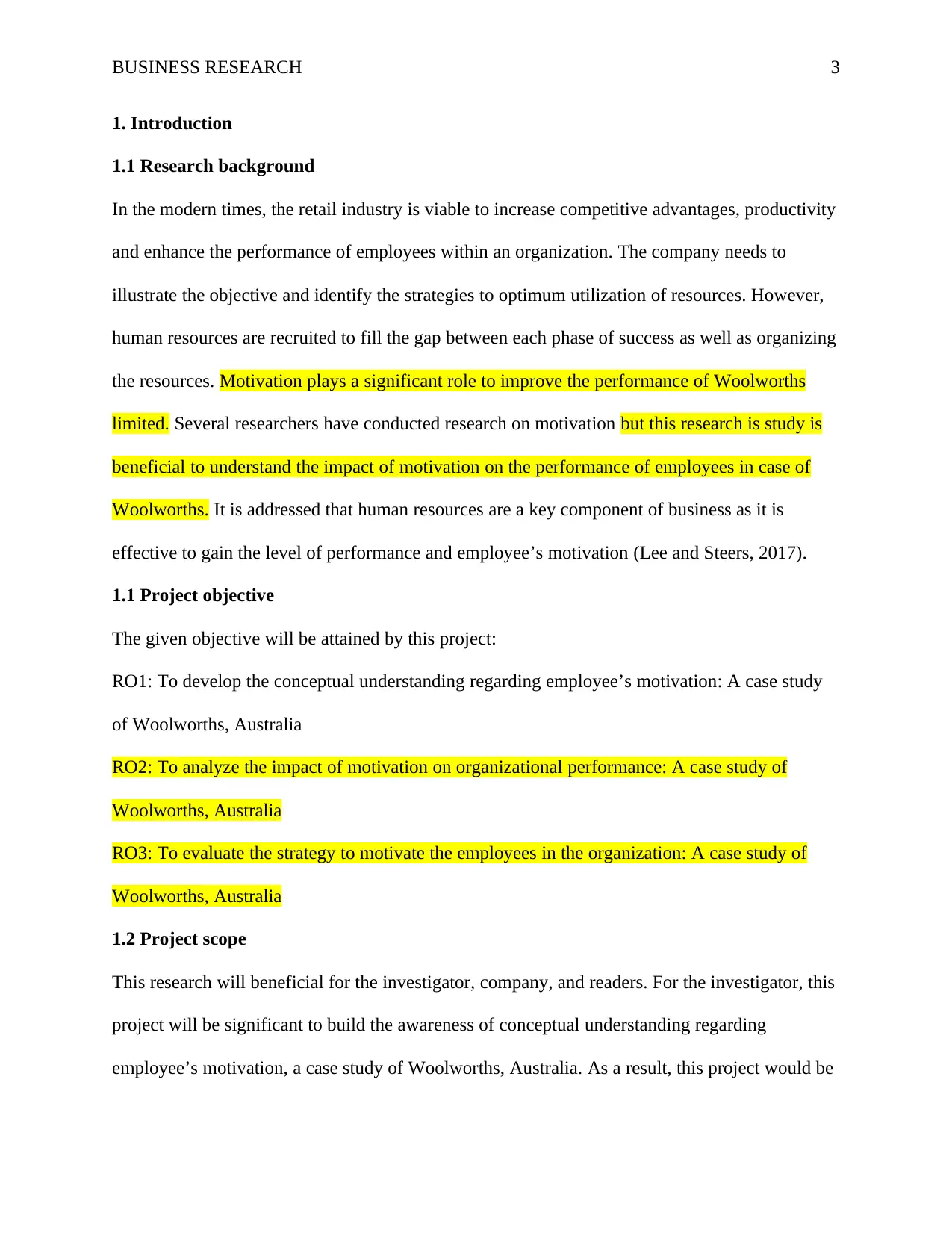
BUSINESS RESEARCH 3
1. Introduction
1.1 Research background
In the modern times, the retail industry is viable to increase competitive advantages, productivity
and enhance the performance of employees within an organization. The company needs to
illustrate the objective and identify the strategies to optimum utilization of resources. However,
human resources are recruited to fill the gap between each phase of success as well as organizing
the resources. Motivation plays a significant role to improve the performance of Woolworths
limited. Several researchers have conducted research on motivation but this research is study is
beneficial to understand the impact of motivation on the performance of employees in case of
Woolworths. It is addressed that human resources are a key component of business as it is
effective to gain the level of performance and employee’s motivation (Lee and Steers, 2017).
1.1 Project objective
The given objective will be attained by this project:
RO1: To develop the conceptual understanding regarding employee’s motivation: A case study
of Woolworths, Australia
RO2: To analyze the impact of motivation on organizational performance: A case study of
Woolworths, Australia
RO3: To evaluate the strategy to motivate the employees in the organization: A case study of
Woolworths, Australia
1.2 Project scope
This research will beneficial for the investigator, company, and readers. For the investigator, this
project will be significant to build the awareness of conceptual understanding regarding
employee’s motivation, a case study of Woolworths, Australia. As a result, this project would be
1. Introduction
1.1 Research background
In the modern times, the retail industry is viable to increase competitive advantages, productivity
and enhance the performance of employees within an organization. The company needs to
illustrate the objective and identify the strategies to optimum utilization of resources. However,
human resources are recruited to fill the gap between each phase of success as well as organizing
the resources. Motivation plays a significant role to improve the performance of Woolworths
limited. Several researchers have conducted research on motivation but this research is study is
beneficial to understand the impact of motivation on the performance of employees in case of
Woolworths. It is addressed that human resources are a key component of business as it is
effective to gain the level of performance and employee’s motivation (Lee and Steers, 2017).
1.1 Project objective
The given objective will be attained by this project:
RO1: To develop the conceptual understanding regarding employee’s motivation: A case study
of Woolworths, Australia
RO2: To analyze the impact of motivation on organizational performance: A case study of
Woolworths, Australia
RO3: To evaluate the strategy to motivate the employees in the organization: A case study of
Woolworths, Australia
1.2 Project scope
This research will beneficial for the investigator, company, and readers. For the investigator, this
project will be significant to build the awareness of conceptual understanding regarding
employee’s motivation, a case study of Woolworths, Australia. As a result, this project would be
⊘ This is a preview!⊘
Do you want full access?
Subscribe today to unlock all pages.

Trusted by 1+ million students worldwide

BUSINESS RESEARCH 4
beneficial for them to conduct further research regarding this subject-matter. It will be also
appropriate for Retail Company to increase the knowledge about the impact of motivation on
organizational performance, a case study of Woolworths, Australia. It will be also imperative for
readers to improve their comprehension about the strategy to motivate the employees in the
organization, a case study of Woolworths, Australia (Barrick, et. al., 2015). Consequently, it
would be feasible for them to use the motivational strategy at the workplace.
2. Summary of Literature review
2.1 RO1: ‘To develop the conceptual understanding regarding employee’s motivation: A
case study of Woolworths, Australia’
It can be summarized that motivation is referred as the factors to activate, lead and carry on the
goal-directed acts. In addition, motivation is a psychological procedure that is used to assess the
attitude of employees within an organization. It also identifies the efforts and level of
determination of workforces. It can be also summarized that motivation could be segregated into
different elements such as intrinsic and extrinsic motivation. Intrinsic motivation created from
self-desire of a person to assess the new things and to deal with the different person. When an
individual has intrinsic motivation then it shows that they perform their task with interest.
Extrinsic motivation is defined as an act that is lead by outsider rewards like grades, praise,
fame, and money. This kind of motivation created from external atmospheres. There are some
factors that drive to extrinsic motivation (Cascio, 2018). For example, competition, rewards,
competition, punishment, and appraisal are used as external factors to encourage the employees.
Under the Expectancy theory of motivation, an individual will motivate to perform two
expectancies. The initial expectation is the probability of attaining desired performance by giving
beneficial for them to conduct further research regarding this subject-matter. It will be also
appropriate for Retail Company to increase the knowledge about the impact of motivation on
organizational performance, a case study of Woolworths, Australia. It will be also imperative for
readers to improve their comprehension about the strategy to motivate the employees in the
organization, a case study of Woolworths, Australia (Barrick, et. al., 2015). Consequently, it
would be feasible for them to use the motivational strategy at the workplace.
2. Summary of Literature review
2.1 RO1: ‘To develop the conceptual understanding regarding employee’s motivation: A
case study of Woolworths, Australia’
It can be summarized that motivation is referred as the factors to activate, lead and carry on the
goal-directed acts. In addition, motivation is a psychological procedure that is used to assess the
attitude of employees within an organization. It also identifies the efforts and level of
determination of workforces. It can be also summarized that motivation could be segregated into
different elements such as intrinsic and extrinsic motivation. Intrinsic motivation created from
self-desire of a person to assess the new things and to deal with the different person. When an
individual has intrinsic motivation then it shows that they perform their task with interest.
Extrinsic motivation is defined as an act that is lead by outsider rewards like grades, praise,
fame, and money. This kind of motivation created from external atmospheres. There are some
factors that drive to extrinsic motivation (Cascio, 2018). For example, competition, rewards,
competition, punishment, and appraisal are used as external factors to encourage the employees.
Under the Expectancy theory of motivation, an individual will motivate to perform two
expectancies. The initial expectation is the probability of attaining desired performance by giving
Paraphrase This Document
Need a fresh take? Get an instant paraphrase of this document with our AI Paraphraser
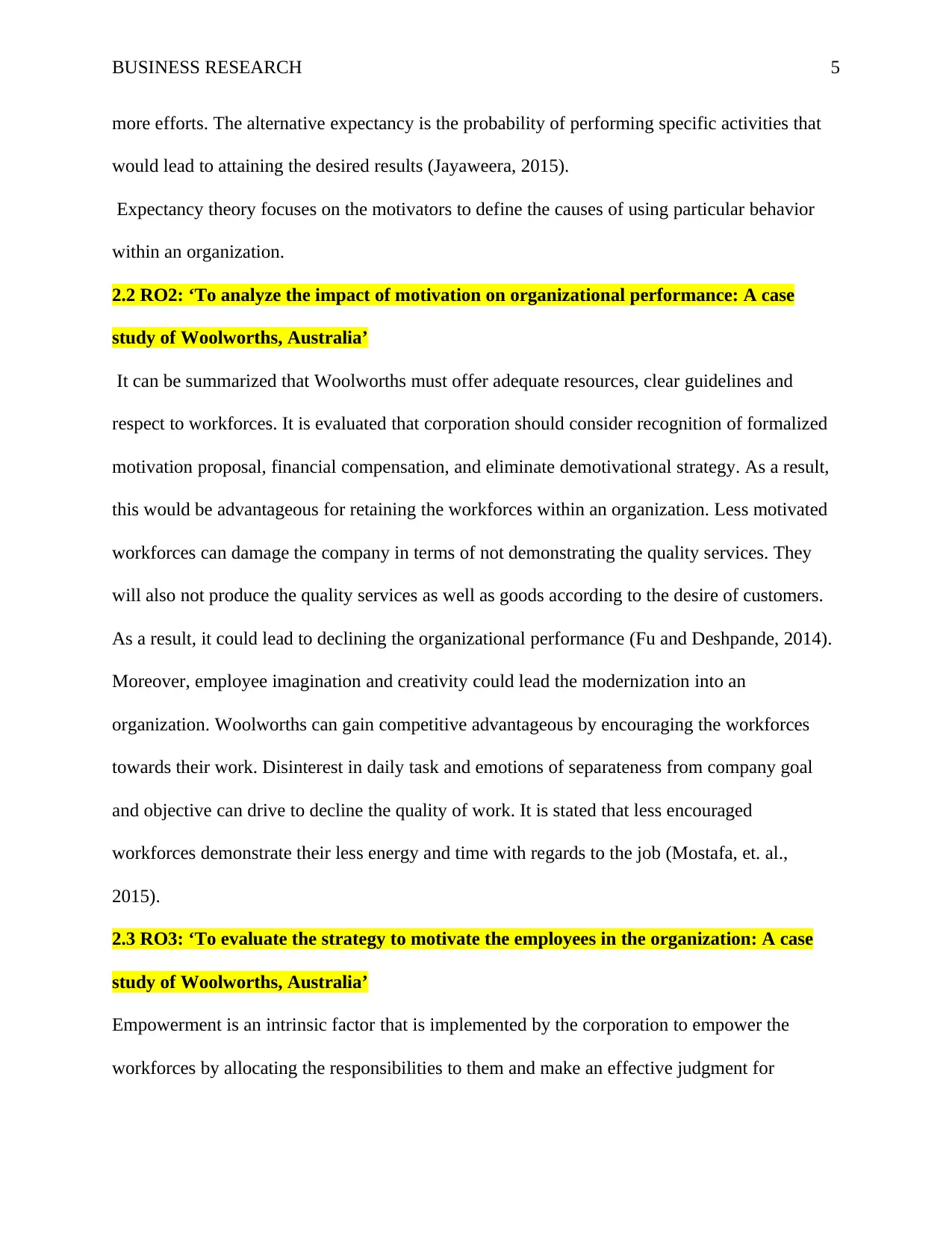
BUSINESS RESEARCH 5
more efforts. The alternative expectancy is the probability of performing specific activities that
would lead to attaining the desired results (Jayaweera, 2015).
Expectancy theory focuses on the motivators to define the causes of using particular behavior
within an organization.
2.2 RO2: ‘To analyze the impact of motivation on organizational performance: A case
study of Woolworths, Australia’
It can be summarized that Woolworths must offer adequate resources, clear guidelines and
respect to workforces. It is evaluated that corporation should consider recognition of formalized
motivation proposal, financial compensation, and eliminate demotivational strategy. As a result,
this would be advantageous for retaining the workforces within an organization. Less motivated
workforces can damage the company in terms of not demonstrating the quality services. They
will also not produce the quality services as well as goods according to the desire of customers.
As a result, it could lead to declining the organizational performance (Fu and Deshpande, 2014).
Moreover, employee imagination and creativity could lead the modernization into an
organization. Woolworths can gain competitive advantageous by encouraging the workforces
towards their work. Disinterest in daily task and emotions of separateness from company goal
and objective can drive to decline the quality of work. It is stated that less encouraged
workforces demonstrate their less energy and time with regards to the job (Mostafa, et. al.,
2015).
2.3 RO3: ‘To evaluate the strategy to motivate the employees in the organization: A case
study of Woolworths, Australia’
Empowerment is an intrinsic factor that is implemented by the corporation to empower the
workforces by allocating the responsibilities to them and make an effective judgment for
more efforts. The alternative expectancy is the probability of performing specific activities that
would lead to attaining the desired results (Jayaweera, 2015).
Expectancy theory focuses on the motivators to define the causes of using particular behavior
within an organization.
2.2 RO2: ‘To analyze the impact of motivation on organizational performance: A case
study of Woolworths, Australia’
It can be summarized that Woolworths must offer adequate resources, clear guidelines and
respect to workforces. It is evaluated that corporation should consider recognition of formalized
motivation proposal, financial compensation, and eliminate demotivational strategy. As a result,
this would be advantageous for retaining the workforces within an organization. Less motivated
workforces can damage the company in terms of not demonstrating the quality services. They
will also not produce the quality services as well as goods according to the desire of customers.
As a result, it could lead to declining the organizational performance (Fu and Deshpande, 2014).
Moreover, employee imagination and creativity could lead the modernization into an
organization. Woolworths can gain competitive advantageous by encouraging the workforces
towards their work. Disinterest in daily task and emotions of separateness from company goal
and objective can drive to decline the quality of work. It is stated that less encouraged
workforces demonstrate their less energy and time with regards to the job (Mostafa, et. al.,
2015).
2.3 RO3: ‘To evaluate the strategy to motivate the employees in the organization: A case
study of Woolworths, Australia’
Empowerment is an intrinsic factor that is implemented by the corporation to empower the
workforces by allocating the responsibilities to them and make an effective judgment for

BUSINESS RESEARCH 6
motivating them. Woolworths can motivate an individual to build innovative and creative ideas
by empowering the workforces within an organization.
Self-improvement allows an employee to use training sessions according to their needs as it
enables them to meet the project goal and objectives. It can encourage the employees in a diverse
way. It is a significant method that is implemented by a company for attaining the needs and
desires of workforces (Zameer, et. al., 2014). There are different tools by which corporation can
encourage the workforces with regards to work like telecommuting, sharing of a job with
compressed workweek. The company should apply the resilience time approach to lead the
workforces towards their jobs. Job rotation strategy should be exercised to allocate the different
jobs to workforces on a provisional basis. The prime intention of applying this approach is to add
different kinds of job and rotate the employees from tasks to another at the workplace
(Bottomley, et. al., 2016).
2.4 Justification of research problem
In the current scenario, the company needs to use different motivational strategy to motivate the
employees. These motivation strategies have a direct impact on the performance of employees.
This research is significant for addressing the impact on employee’s motivation on the
performance of employees. This research is also beneficial for addressing the motivational
strategies to enhance the organizational performance (Mone and London, 2018).
2.5 Literature gap and opportunity
Under the literature review, a researcher will focus on the impact of employee’s motivation on
organizational performance. This literature review also provides the opportunity to assess the
impact of employee’s motivation on the organizational performance. This investigation will
emphasize on the strategy to motivate the employees. An investigator will use small sample size
motivating them. Woolworths can motivate an individual to build innovative and creative ideas
by empowering the workforces within an organization.
Self-improvement allows an employee to use training sessions according to their needs as it
enables them to meet the project goal and objectives. It can encourage the employees in a diverse
way. It is a significant method that is implemented by a company for attaining the needs and
desires of workforces (Zameer, et. al., 2014). There are different tools by which corporation can
encourage the workforces with regards to work like telecommuting, sharing of a job with
compressed workweek. The company should apply the resilience time approach to lead the
workforces towards their jobs. Job rotation strategy should be exercised to allocate the different
jobs to workforces on a provisional basis. The prime intention of applying this approach is to add
different kinds of job and rotate the employees from tasks to another at the workplace
(Bottomley, et. al., 2016).
2.4 Justification of research problem
In the current scenario, the company needs to use different motivational strategy to motivate the
employees. These motivation strategies have a direct impact on the performance of employees.
This research is significant for addressing the impact on employee’s motivation on the
performance of employees. This research is also beneficial for addressing the motivational
strategies to enhance the organizational performance (Mone and London, 2018).
2.5 Literature gap and opportunity
Under the literature review, a researcher will focus on the impact of employee’s motivation on
organizational performance. This literature review also provides the opportunity to assess the
impact of employee’s motivation on the organizational performance. This investigation will
emphasize on the strategy to motivate the employees. An investigator will use small sample size
⊘ This is a preview!⊘
Do you want full access?
Subscribe today to unlock all pages.

Trusted by 1+ million students worldwide
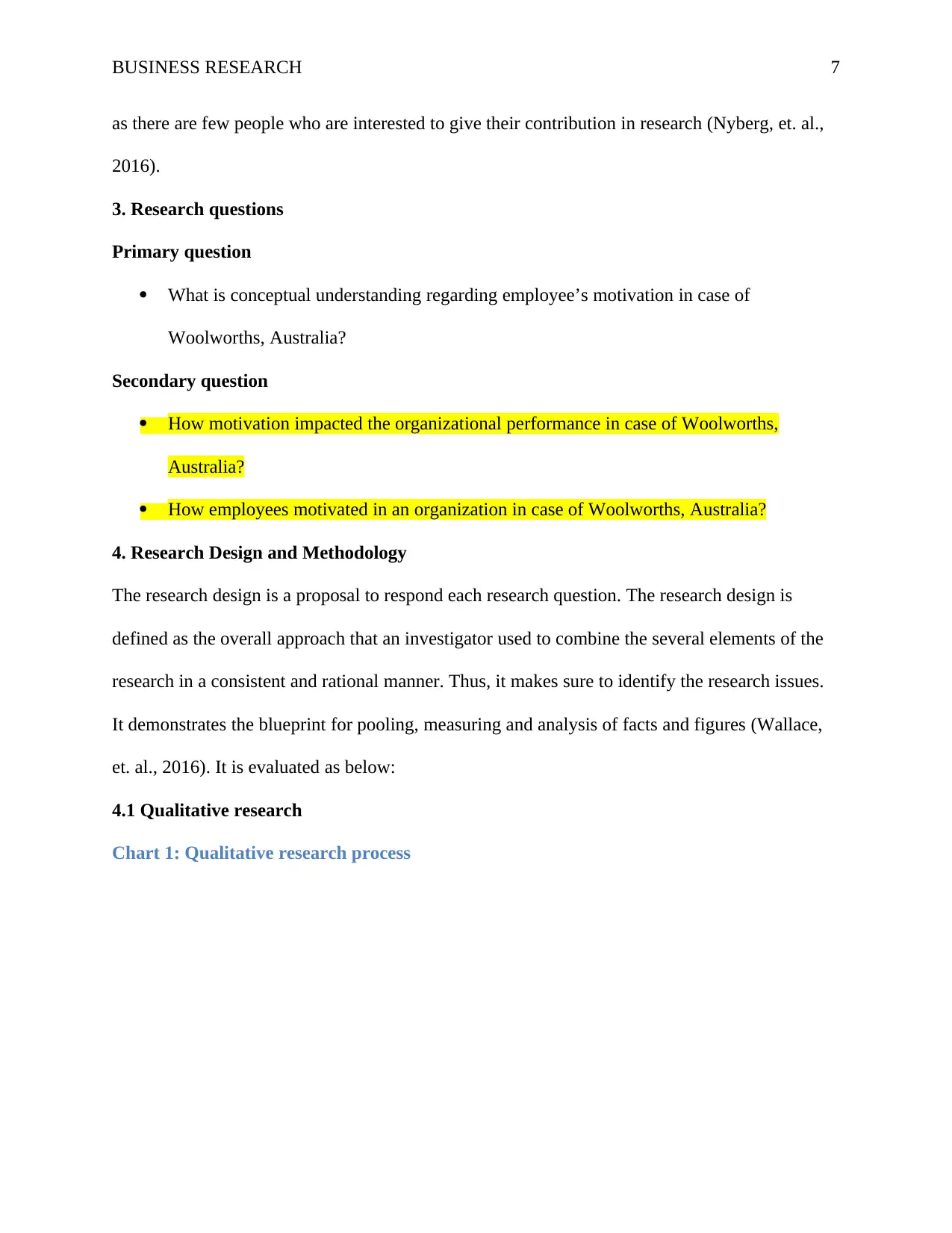
BUSINESS RESEARCH 7
as there are few people who are interested to give their contribution in research (Nyberg, et. al.,
2016).
3. Research questions
Primary question
What is conceptual understanding regarding employee’s motivation in case of
Woolworths, Australia?
Secondary question
How motivation impacted the organizational performance in case of Woolworths,
Australia?
How employees motivated in an organization in case of Woolworths, Australia?
4. Research Design and Methodology
The research design is a proposal to respond each research question. The research design is
defined as the overall approach that an investigator used to combine the several elements of the
research in a consistent and rational manner. Thus, it makes sure to identify the research issues.
It demonstrates the blueprint for pooling, measuring and analysis of facts and figures (Wallace,
et. al., 2016). It is evaluated as below:
4.1 Qualitative research
Chart 1: Qualitative research process
as there are few people who are interested to give their contribution in research (Nyberg, et. al.,
2016).
3. Research questions
Primary question
What is conceptual understanding regarding employee’s motivation in case of
Woolworths, Australia?
Secondary question
How motivation impacted the organizational performance in case of Woolworths,
Australia?
How employees motivated in an organization in case of Woolworths, Australia?
4. Research Design and Methodology
The research design is a proposal to respond each research question. The research design is
defined as the overall approach that an investigator used to combine the several elements of the
research in a consistent and rational manner. Thus, it makes sure to identify the research issues.
It demonstrates the blueprint for pooling, measuring and analysis of facts and figures (Wallace,
et. al., 2016). It is evaluated as below:
4.1 Qualitative research
Chart 1: Qualitative research process
Paraphrase This Document
Need a fresh take? Get an instant paraphrase of this document with our AI Paraphraser
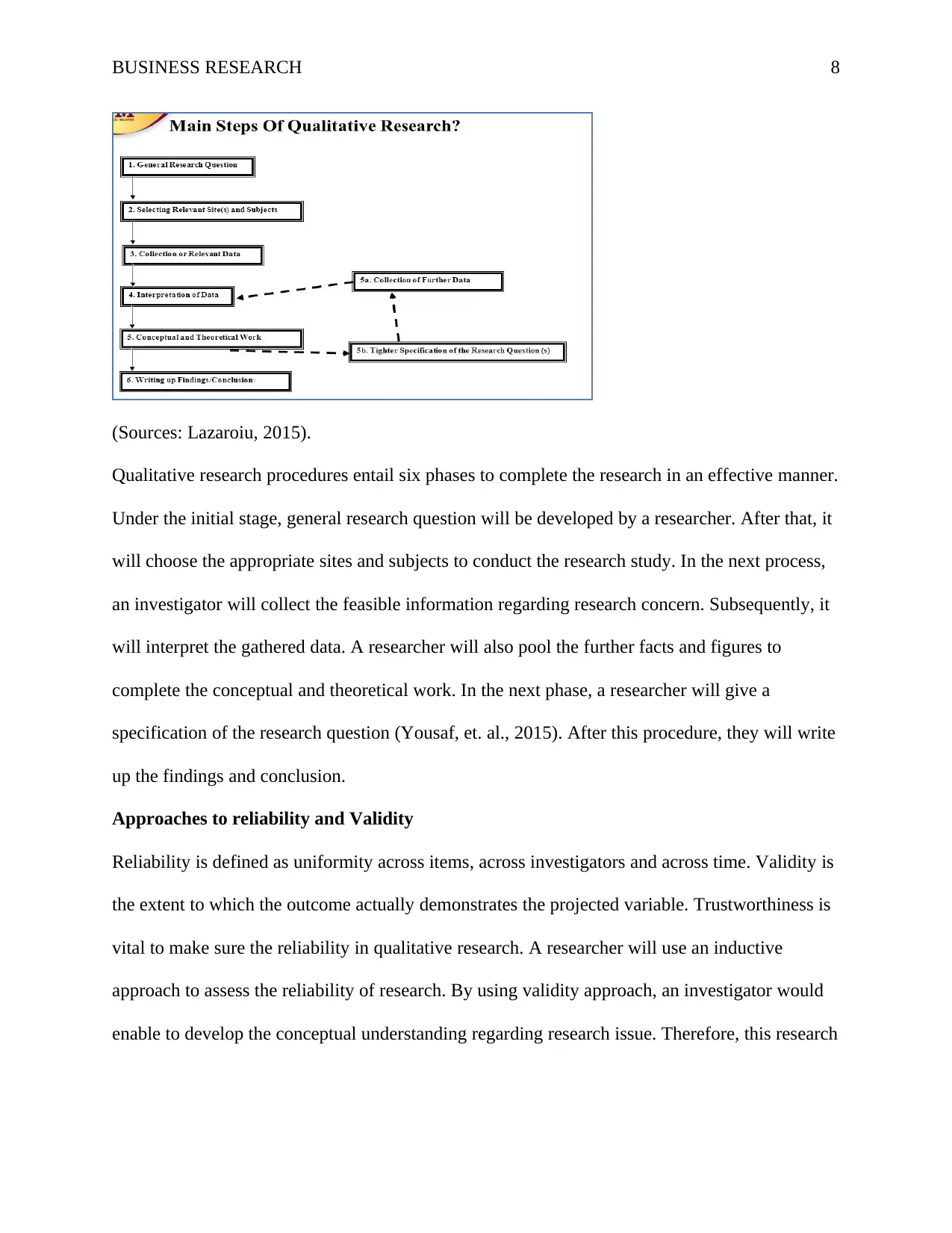
BUSINESS RESEARCH 8
(Sources: Lazaroiu, 2015).
Qualitative research procedures entail six phases to complete the research in an effective manner.
Under the initial stage, general research question will be developed by a researcher. After that, it
will choose the appropriate sites and subjects to conduct the research study. In the next process,
an investigator will collect the feasible information regarding research concern. Subsequently, it
will interpret the gathered data. A researcher will also pool the further facts and figures to
complete the conceptual and theoretical work. In the next phase, a researcher will give a
specification of the research question (Yousaf, et. al., 2015). After this procedure, they will write
up the findings and conclusion.
Approaches to reliability and Validity
Reliability is defined as uniformity across items, across investigators and across time. Validity is
the extent to which the outcome actually demonstrates the projected variable. Trustworthiness is
vital to make sure the reliability in qualitative research. A researcher will use an inductive
approach to assess the reliability of research. By using validity approach, an investigator would
enable to develop the conceptual understanding regarding research issue. Therefore, this research
(Sources: Lazaroiu, 2015).
Qualitative research procedures entail six phases to complete the research in an effective manner.
Under the initial stage, general research question will be developed by a researcher. After that, it
will choose the appropriate sites and subjects to conduct the research study. In the next process,
an investigator will collect the feasible information regarding research concern. Subsequently, it
will interpret the gathered data. A researcher will also pool the further facts and figures to
complete the conceptual and theoretical work. In the next phase, a researcher will give a
specification of the research question (Yousaf, et. al., 2015). After this procedure, they will write
up the findings and conclusion.
Approaches to reliability and Validity
Reliability is defined as uniformity across items, across investigators and across time. Validity is
the extent to which the outcome actually demonstrates the projected variable. Trustworthiness is
vital to make sure the reliability in qualitative research. A researcher will use an inductive
approach to assess the reliability of research. By using validity approach, an investigator would
enable to develop the conceptual understanding regarding research issue. Therefore, this research

BUSINESS RESEARCH 9
would be vital for improving the reliability of the validity of research result (Van De Voorde and
Beijer, 2015).
Qualitative data analysis process
Chart 2: Qualitative data analysis process
(Sources: Lazaroiu, 2015).
Qualitative data analysis is the range of practices and process where an investigator move
towards the qualitative information that have been gathered into some sort of explanation,
interpretation of people, and circumstances of investigation. Qualitative data analysis (QDA) is
relied on the interpretative philosophy. The key aspect of assessing the meaningful and symbolic
content of qualitative information is to entail the two things such as writing and identification of
themes. Writing of some type is found in all sort of QDA. As well as, finding themes is a
element of overwhelming the majority of QDA.
would be vital for improving the reliability of the validity of research result (Van De Voorde and
Beijer, 2015).
Qualitative data analysis process
Chart 2: Qualitative data analysis process
(Sources: Lazaroiu, 2015).
Qualitative data analysis is the range of practices and process where an investigator move
towards the qualitative information that have been gathered into some sort of explanation,
interpretation of people, and circumstances of investigation. Qualitative data analysis (QDA) is
relied on the interpretative philosophy. The key aspect of assessing the meaningful and symbolic
content of qualitative information is to entail the two things such as writing and identification of
themes. Writing of some type is found in all sort of QDA. As well as, finding themes is a
element of overwhelming the majority of QDA.
⊘ This is a preview!⊘
Do you want full access?
Subscribe today to unlock all pages.

Trusted by 1+ million students worldwide
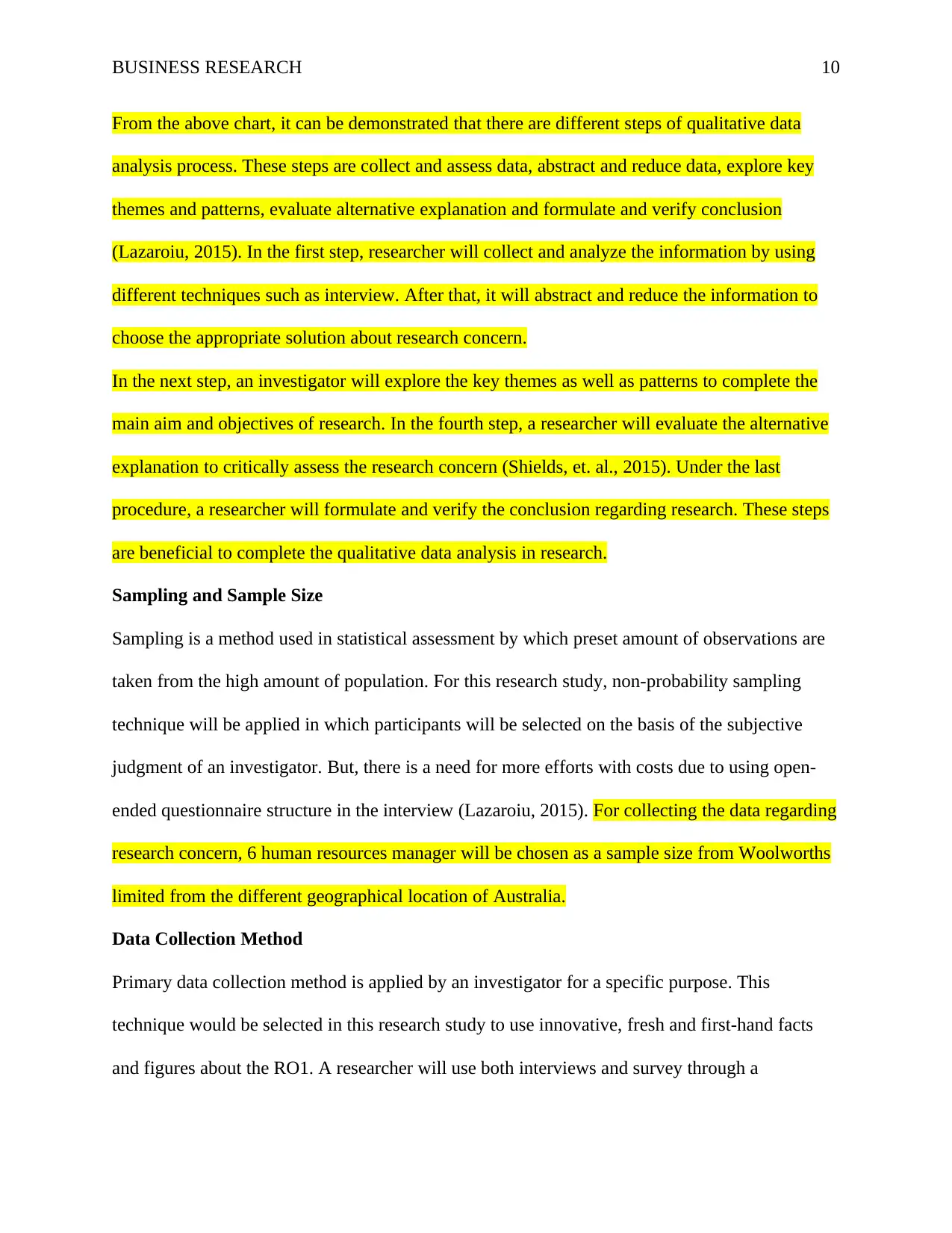
BUSINESS RESEARCH 10
From the above chart, it can be demonstrated that there are different steps of qualitative data
analysis process. These steps are collect and assess data, abstract and reduce data, explore key
themes and patterns, evaluate alternative explanation and formulate and verify conclusion
(Lazaroiu, 2015). In the first step, researcher will collect and analyze the information by using
different techniques such as interview. After that, it will abstract and reduce the information to
choose the appropriate solution about research concern.
In the next step, an investigator will explore the key themes as well as patterns to complete the
main aim and objectives of research. In the fourth step, a researcher will evaluate the alternative
explanation to critically assess the research concern (Shields, et. al., 2015). Under the last
procedure, a researcher will formulate and verify the conclusion regarding research. These steps
are beneficial to complete the qualitative data analysis in research.
Sampling and Sample Size
Sampling is a method used in statistical assessment by which preset amount of observations are
taken from the high amount of population. For this research study, non-probability sampling
technique will be applied in which participants will be selected on the basis of the subjective
judgment of an investigator. But, there is a need for more efforts with costs due to using open-
ended questionnaire structure in the interview (Lazaroiu, 2015). For collecting the data regarding
research concern, 6 human resources manager will be chosen as a sample size from Woolworths
limited from the different geographical location of Australia.
Data Collection Method
Primary data collection method is applied by an investigator for a specific purpose. This
technique would be selected in this research study to use innovative, fresh and first-hand facts
and figures about the RO1. A researcher will use both interviews and survey through a
From the above chart, it can be demonstrated that there are different steps of qualitative data
analysis process. These steps are collect and assess data, abstract and reduce data, explore key
themes and patterns, evaluate alternative explanation and formulate and verify conclusion
(Lazaroiu, 2015). In the first step, researcher will collect and analyze the information by using
different techniques such as interview. After that, it will abstract and reduce the information to
choose the appropriate solution about research concern.
In the next step, an investigator will explore the key themes as well as patterns to complete the
main aim and objectives of research. In the fourth step, a researcher will evaluate the alternative
explanation to critically assess the research concern (Shields, et. al., 2015). Under the last
procedure, a researcher will formulate and verify the conclusion regarding research. These steps
are beneficial to complete the qualitative data analysis in research.
Sampling and Sample Size
Sampling is a method used in statistical assessment by which preset amount of observations are
taken from the high amount of population. For this research study, non-probability sampling
technique will be applied in which participants will be selected on the basis of the subjective
judgment of an investigator. But, there is a need for more efforts with costs due to using open-
ended questionnaire structure in the interview (Lazaroiu, 2015). For collecting the data regarding
research concern, 6 human resources manager will be chosen as a sample size from Woolworths
limited from the different geographical location of Australia.
Data Collection Method
Primary data collection method is applied by an investigator for a specific purpose. This
technique would be selected in this research study to use innovative, fresh and first-hand facts
and figures about the RO1. A researcher will use both interviews and survey through a
Paraphrase This Document
Need a fresh take? Get an instant paraphrase of this document with our AI Paraphraser
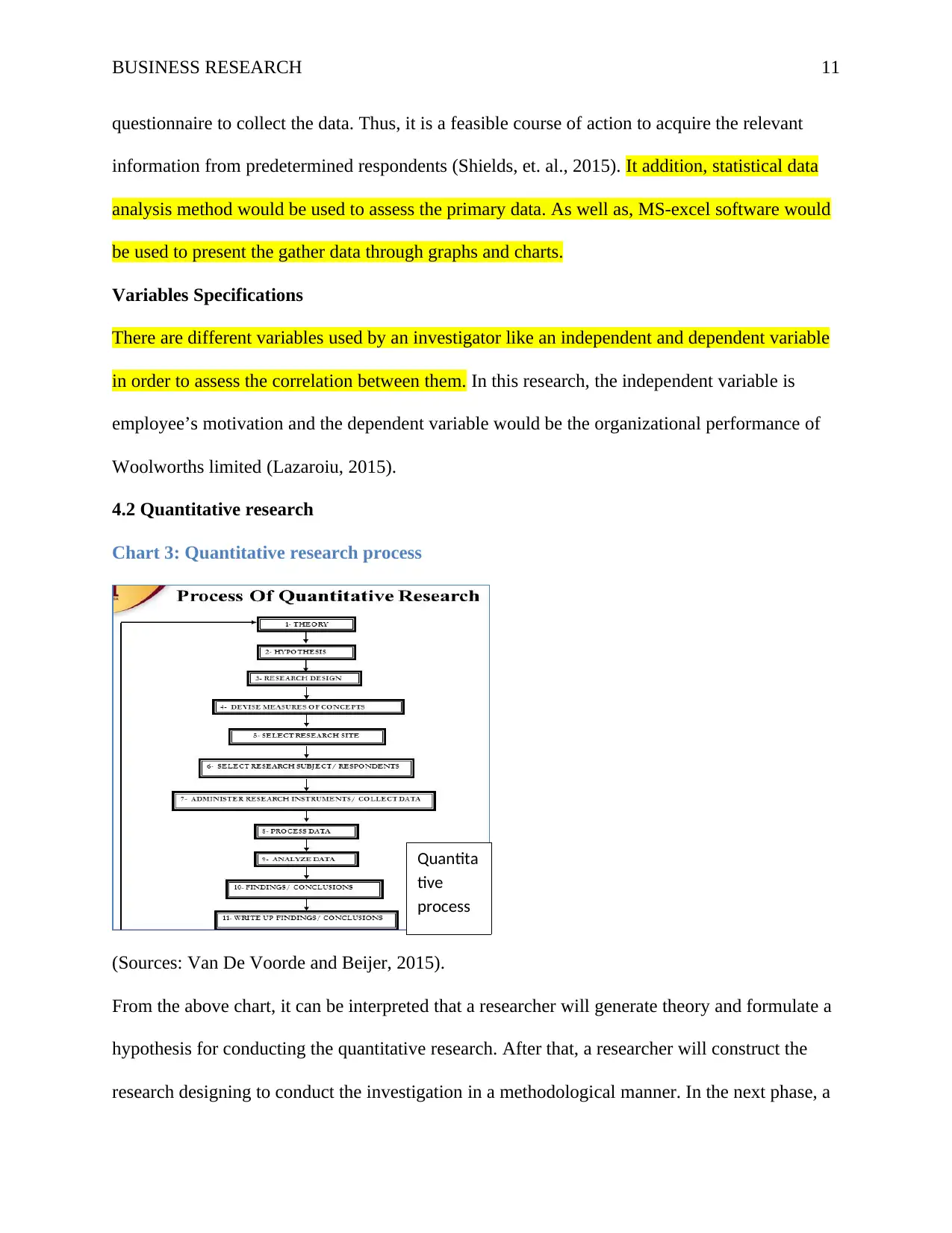
BUSINESS RESEARCH 11
questionnaire to collect the data. Thus, it is a feasible course of action to acquire the relevant
information from predetermined respondents (Shields, et. al., 2015). It addition, statistical data
analysis method would be used to assess the primary data. As well as, MS-excel software would
be used to present the gather data through graphs and charts.
Variables Specifications
There are different variables used by an investigator like an independent and dependent variable
in order to assess the correlation between them. In this research, the independent variable is
employee’s motivation and the dependent variable would be the organizational performance of
Woolworths limited (Lazaroiu, 2015).
4.2 Quantitative research
Chart 3: Quantitative research process
(Sources: Van De Voorde and Beijer, 2015).
From the above chart, it can be interpreted that a researcher will generate theory and formulate a
hypothesis for conducting the quantitative research. After that, a researcher will construct the
research designing to conduct the investigation in a methodological manner. In the next phase, a
Quantita
tive
process
questionnaire to collect the data. Thus, it is a feasible course of action to acquire the relevant
information from predetermined respondents (Shields, et. al., 2015). It addition, statistical data
analysis method would be used to assess the primary data. As well as, MS-excel software would
be used to present the gather data through graphs and charts.
Variables Specifications
There are different variables used by an investigator like an independent and dependent variable
in order to assess the correlation between them. In this research, the independent variable is
employee’s motivation and the dependent variable would be the organizational performance of
Woolworths limited (Lazaroiu, 2015).
4.2 Quantitative research
Chart 3: Quantitative research process
(Sources: Van De Voorde and Beijer, 2015).
From the above chart, it can be interpreted that a researcher will generate theory and formulate a
hypothesis for conducting the quantitative research. After that, a researcher will construct the
research designing to conduct the investigation in a methodological manner. In the next phase, a
Quantita
tive
process

BUSINESS RESEARCH 12
researcher will choose the appropriate device to measure the concept and also choose the feasible
site for research. In the sixth phase, a researcher will select the research subjects as well as a
participant to conduct the research. Subsequently, the researcher will manage the instruments of
research and pool the facts and figures regarding research concern. After that data will be
processed into the research. In the next stage, data will be analyzed by a researcher and also
interpret the findings (Shields, et. al., 2015). In the last, whole research will be concluded by a
research in quantitative research.
Research Instrument
A research instrument is a technique for pooling, measuring and assessing the information
associated with the research subject. The secondary information would be applied for completing
this investigation. This information will be sourced via different tools like textbooks, academic
publications, online and offline materials and government publications. This research instrument
would be practiced by an investigator to support the primary sources. For obtaining the survey
through a questionnaire, an investigator will select 60 employees as a sample size from
Woolworths limited. As a result, it would be vital for obtaining the reliable outcome (Wallace,
et. al., 2016).
Quantitative Data Analysis Process
Chart 4: Quantitative data analysis process
researcher will choose the appropriate device to measure the concept and also choose the feasible
site for research. In the sixth phase, a researcher will select the research subjects as well as a
participant to conduct the research. Subsequently, the researcher will manage the instruments of
research and pool the facts and figures regarding research concern. After that data will be
processed into the research. In the next stage, data will be analyzed by a researcher and also
interpret the findings (Shields, et. al., 2015). In the last, whole research will be concluded by a
research in quantitative research.
Research Instrument
A research instrument is a technique for pooling, measuring and assessing the information
associated with the research subject. The secondary information would be applied for completing
this investigation. This information will be sourced via different tools like textbooks, academic
publications, online and offline materials and government publications. This research instrument
would be practiced by an investigator to support the primary sources. For obtaining the survey
through a questionnaire, an investigator will select 60 employees as a sample size from
Woolworths limited. As a result, it would be vital for obtaining the reliable outcome (Wallace,
et. al., 2016).
Quantitative Data Analysis Process
Chart 4: Quantitative data analysis process
⊘ This is a preview!⊘
Do you want full access?
Subscribe today to unlock all pages.

Trusted by 1+ million students worldwide
1 out of 18
Related Documents
Your All-in-One AI-Powered Toolkit for Academic Success.
+13062052269
info@desklib.com
Available 24*7 on WhatsApp / Email
![[object Object]](/_next/static/media/star-bottom.7253800d.svg)
Unlock your academic potential
Copyright © 2020–2025 A2Z Services. All Rights Reserved. Developed and managed by ZUCOL.



